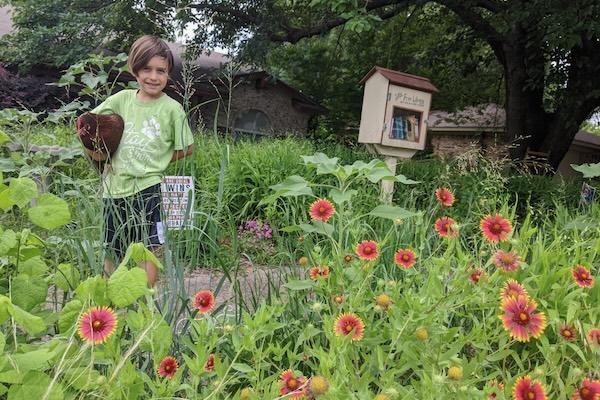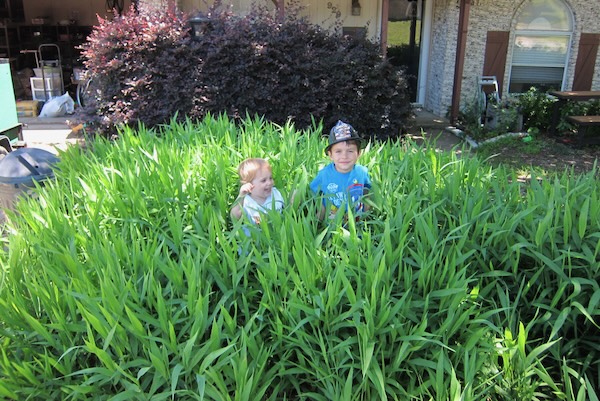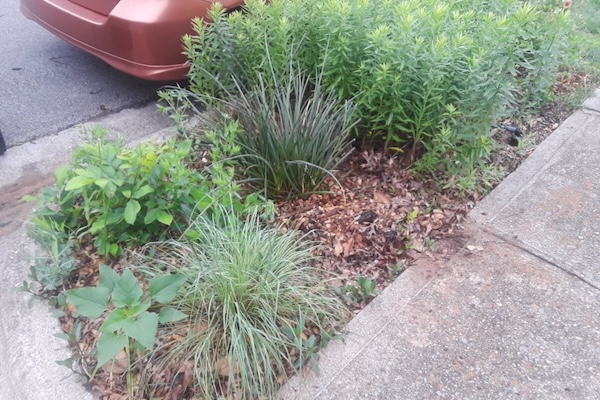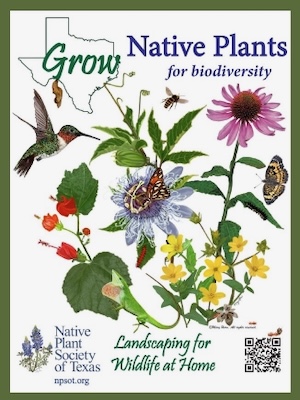
Grapevine resident Tim Yatko has been fighting citations for his native plant landscaping for nearly two years. Above, Cyril Yatko and pet chicken enjoy the wildflowers in the Yatko's front yard. Photo by Tim Yatko.
Turf-grass yards, long the standard landscape of suburbia, have come under scrutiny in recent years.
From a New York Times opinion piece titled Kill Your Lawn to this story calling out the “futility and stupidity of the American lawn,” there’s no shortage of online ammo aimed at obliterating that water-sucking, chemically sterilized, emerald-green symbol of American home ownership.
Turf grass is the nation’s largest irrigated crop. It guzzles tens of millions of pounds of herbicides and pesticides annually. Mowing and trimming one lawn for one year blows an average of 563 pounds of CO2 into the already besieged atmosphere.
Thus, the yard critics say: Turf yards have got to go.
LAWN LOVERS DIG IN
But old habits die hard. Here in North Texas, house dwellers revere their closely cropped green thatch. And while several Metroplex cities have begun embracing the concept of water-saving native-plant yards (more on that later), most city codes here are helping to keep the clipped-turf tradition alive.
Tim Yatko, a Grapevine resident who is both a Master Gardener and Master Naturalist, has been pushing hard to shift the paradigm.
“Turf grass is a man-made construct — something that kings and nobility did to show that they had so much land they didn’t have to give it all up to grow food,” Yatko said.
He has learned the hard way that the loose congregation of native plants waving above his yard offend some of his neighbors’ sensibilities and are in apparent conflict with what he views as a vaguely worded city code.
“Turf grass is a man-made construct — something that kings and nobility did to show that they had so much land they didn’t have to give it all up to grow food,” Yatko said.
“The code does not allow ‘to suffer or permit grass, weeds or any plant that is not cultivated to grow to a greater height than six inches on an average upon said premises,’” Yatko said, quoting the city code verbatim. “There is no definition of grass, so the code does not distinguish between turf grass and native ornamentals. There is no definition of ‘weed.’ So, in my experience, anything that Code Enforcement does not recognize as a grass is a weed. There is no definition of cultivation, so anything that is not boxed in a flower bed is uncultivated.”
In other words, the code is open to subjective interpretation, Yatko surmises, and in the hands of a code officer looking to close out complaints from neighbors who dislike a free-form aesthetic, “it is easy to cite and fine people.”
The city sees things a bit differently: “The city’s current code adequately and clearly addresses the city’s landscaping standards,” Grapevine City Attorney Matthew Boyle said in a statement to Green Source DFW. “The current code already addresses non-traditional landscaping choices.”
GRASS ROOTS MOVEMENT
 Cecilila and Cyril play in a Texas native grass known as inland sea oats in the Yatko's yard. Courtesy of Tim Yatko.
Cecilila and Cyril play in a Texas native grass known as inland sea oats in the Yatko's yard. Courtesy of Tim Yatko.
Yatko has been tussling with the city for nearly two years now, fighting citations for overgrown vegetation and trying to get officials to update codes and more strongly encourage native residential plantings. Grapevine’s residential grass-height limit of six inches is a more aggressive standard than most other DFW cities (Dallas, Fort Worth, Arlington and other municipalities have 12-inch limits). So, as the seasons progress, Yatko’s wildscape climbs high, and the city comes knocking.
“It stresses me out. I never know if I am going to get another letter in my mailbox for a code violation that code officers have never fully explained since they are not gardeners themselves,” Yatko said. “To them, anything they don’t understand is a weed.”
Landscape irrigation consumes about one third of U.S. families’ water-use total, according to the U.S. Environmental Protection Agency.
His enthusiasm for drought-hardy native vegetation is based partly on a distressing statistic: Landscape irrigation consumes about one third of U.S. families’ water-use total, according to the U.S. Environmental Protection Agency. That pencils out to more than three trillion gallons a year just to keep thirsty lawns perked up. Conversely, with native Texas grasses and other flora, a little water goes a long way. Even with clothes washing, bathing, flushing, cooking and all other water uses factored in, the Yatko family’s total monthly water bill never touches the 1,000 gallon-per-month minimum he’s required to pay.
 The Yatko's drought tolerant landscaping offers curbside appeal to pollinators and native wildlife. Courtesy of Tim Yatko.
The Yatko's drought tolerant landscaping offers curbside appeal to pollinators and native wildlife. Courtesy of Tim Yatko.
Water savings is just part of the appeal. Yatko’s yard requires no fertilizer. And insecticides are off the menu because, as intended, the multicolored wildflowers draw in legions of butterflies, bees and other beneficial insects. Birds, too. Such environmental perks are what motivated Yatko in 2012 to dig up his turf-grass yard and replace it with frogfruit, purple coneflower, inland sea oats, black-eyed Susan and other indigenous plant varieties (a full list is at the end of this article), some of which eventually rise two to four feet above the soil. He cuts them back each February.
“The benefits of native, non-turf grass lawns and gardens are numerous. My top two are less water usage and no chemicals,” he said. “[With] turf grass you have to stand behind a loud mower, water more, and if you really want a green golf lawn, you need to apply fertilizers and pesticides.”
FUTURE WATER NEEDS
With DFW’s population recently blowing past 8 million, future water demand threatens to outstrip supply. Yatko believes a sharper focus on residential water conservation, particularly the substitution of dry-climate plants for St. Augustine grass and other thirsty thatches, could help relieve that pressure. It might also avert the need for controversial infrastructure additions like the $7 billion Marvin Nichols Reservoir, a proposed East Texas lake that would pipe water to the voracious DFW area. The reservoir’s construction would involve flooding 66,000 acres of forest, farms and wetlands, and displacing scores of Texans whose families have lived and worked in the area for generations.
“We should be worried about cities making native plants illegal, given that water conservation through landscaping is critical if North Texas wants to stretch what water resources it does have before investing in costly infrastructure projects,” Yatko said.
Grapevine may update its code soon, possibly to further accommodate xeriscaped yards.
“Any potential updates and revisions to the code will be considered in the next month or two,” City Attorney Boyle said.
SHIFTING WINDS
Yatko hopes his city joins a growing list of other DFW communities like Lewisville, which is encouraging residents to take up native gardening with its Roots for Wings program, and Flower Mound, where city code distinguishes between turf and non-turf lawns, defines weeds objectively and grants exemptions to native yards.
 The Native Plant Society of Texas has been a pioneer in the native plant movement since 1980. Purchase a metal yard sign for $29.
The Native Plant Society of Texas has been a pioneer in the native plant movement since 1980. Purchase a metal yard sign for $29.
Likewise, the City of Duncanville recently approved a new rule encouraging residential wildscapes.
“This ordinance allows residents to incorporate native grasses and plants into their residential yards, promoting sustainable landscaping practices,” said Tyler Agee, Duncanville’s assistant director of Parks and Recreation. “Before its passage, the city had been proactive in promoting native landscaping. For instance, the Keep Duncanville Beautiful Board hosted a native landscaping workshop on July 27, providing residents with information on local pollinators, Texas native plants and the native-landscape application process.”
Agee notes that the advantages of such plantings include supporting local wildlife with seeds, nectar and shelter.
“By allowing native plants in residential landscapes, Duncanville can enhance local biodiversity, conserve resources and promote sustainable gardening practices,” Agee said.
Other Metroplex cities and counties also are encouraging low-water-use landscaping. Dallas and Plano each host an annual Waterwise Landscape Tour, Arlington has a Native Plant and Pollinator Demo Garden as well as the Molly Hollar Wildscape, and the Tarrant Regional Water District promotes Native Plant Demo Gardens throughout Fort Worth and Tarrant County.
Back in Grapevine, Tim Yatko senses a groundswell of support for bolstering the city code that governs residential native landscaping.
“The number of Grapevine residents who support the code revamp is growing,” he said.
The city of Arlington Native Plant and Pollinator Demo Garden showcases drought tolerant and native landscaping. Photo by Michael Smith.
TIM YATKO'S NATIVE PLANT RECOMMENDATIONS
The Yatko family yard is planted with these native species:
Frogfruit (ground cover)
Purple Coneflower (perennial pollinator)
Black-eyed Susan (perennial pollinator)
Lantana (perennial pollinator)
Inland Sea Oats (perennial, shade tolerant)
Turk’s Cap (perennial, shade tolerant, pollinator)
Switchgrass (perennial)
Big Bluestem (perennial)
Little Bluestem (perennial)
Indiangrass (perennial)
Greg’s Purple Mistflower (perennial, ground cover, pollinator)
Coral Honeysuckle (perennial vine, pollinator)
Maximilian Sunflower (perennial, pollinator)
Cowpen Daisy (Annual, pollinator)
Indian Blanket (Annual, pollinator)
RELATED ARTICLES
New Arlington garden showcases summer survivors
Namesake of Molly Hollar Wildscape to be celebrated Saturday
New native plant group hoping to take root in DFW
Ecosystem's survival tied to prevalence of native plants, author says
